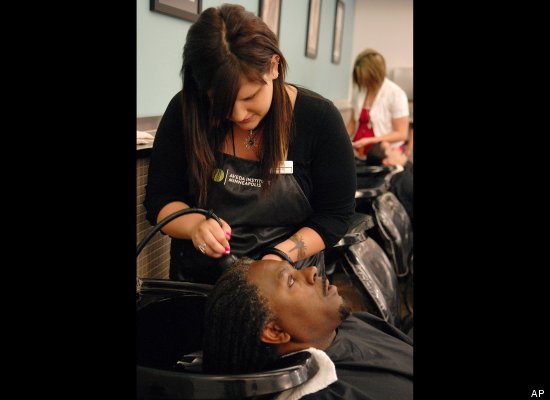The 10 Worst-Paying States for Women
November 2, 2012 by Mike SauterIn 2011, men working full-time earned a median of $48,765. Women earned just $38,373. That difference of more than $10,000 only tells part of the story of the continuing gender wage gap in this country. Depending on the industry, men in some states earn as much as $20,000 to $30,000 more a year than women. In some cases, the difference is even more. Men in corporate managerial positions earn roughly $35,000 more than women working full time in the same field.
Income inequality is severe in some industries, and there are states with concentrations of these businesses. In these states, the gender earnings gap for full-time workers is extremely high. In Wyoming, where there are several of these ”pay disparity” occupations, women earned $17,838 less than men in 2011 — the largest disparity among all states. Based on data from the Census Bureau’s 2011 American Community Survey, 24/7 Wall St. identified the worst-paying states for women.

In an interview with 24/7 Wall St., Institute for Women’s Policy Research study director Ariane Hegewisch explained that the biggest reason for the pay gap between men and women in these states came down to where people are employed. While the gap in pay still exists in nearly every occupation, she said, it is much narrower in fields such as health care, education and real estate. Nationally, the income gap for educational services is $7,408, while in real estate it is less than $5,000.
In states where more people are employed in blue-collar work, women are more likely to work in sectors where the pay is much lower than men in blue-collar positions.
Hegewisch explained that in states where more workers are blue collar, men are able to find employment in jobs such as resource collection and construction — positions that are still predominantly male and allow for bonuses and overtime and generally higher pay. In North Dakota, for example, the booming natural gas industry employs hundreds of thousands of workers. In 2011, 90.9% of oil, mining and extraction workers in the state were male. Those few women who were employed in that industry earned $46,301 less than men. All five states with the highest proportions of workers in this field are among the 10 with the highest gender wage gap.
In states like North Dakota, women are often left to work in lower-paying fields, especially retail. While the income gender gap is closer to the national wage gap in this field, at less than $9,000, the fact that a disproportionately large number of women are employed in this field results in a wide income gap statewide. In West Virginia — which has one of the greatest gender wage gaps in the country — the largest employer is Wal-Mart Stores Inc. (NYSE: WMT). As of 2011, 54.8% of West Virginian retail workers were women, the third-highest proportion in the country. Women working full-time in retail in West Virginia earned a median of just $14,304.
In the states with the largest wage gap between men and women, it is not always the case that full-time income for women is lower than in other states. In five of the 10 states, income for women was among the top 10 in the country. However, in those states, earnings among men were even higher. For example, in Massachusetts, women working full-time earned a median of $47,302, the fourth highest in the country. Men in the state, however, earned more than $60,000.
The gap in pay in some of these states is even more pronounced in their cities. In five major metropolitan statistical areas, male pay exceeds female pay by at least $20,000. Most of the 10 metro areas with the widest gender pay gap are in the 10 states with the highest pay gaps. In Casper, Wy., which has the worst pay gap in the country, men earn more than $25,000 more than women.
To identify the states that pay women the least, 24/7 Wall St. compared the median incomes for the past 12 months of both men and women who worked full-time, year-round in each state, based on data collected by the U.S. Census Bureau and released as part of the 2011 American Community Survey report. From the ACS, we included in our analysis the proportion of workers in state employed in each industry, as well as the gender distribution and gender-specific income in each of these industries. We also reviewed 2011 unemployment rates.
These are the 10 worst-paying states for women.
10. North Dakota
>Difference in full-time, year-round income: $12,955
>Female full-time, year-round median income: $33,792 (11th lowest)
>Male full-time, year-round median income: $46,747 (25th highest)
>2011 unemployment rate: 3.5% (the lowest)
North Dakota’s unemployment rate was the lowest in the country in 2011 at 3.5%, but the jobs that pay larger salaries were primarily in male-dominated industries. The state is in the midst of an oil boom, an industry that is attracting predominantly young men to work in the oil fields for relatively high pay. More than 13% of state workers were employed in natural resources, construction and maintenance, while more than 9% were employed in agriculture, forestry, fishing and hunting and mining, both the second highest among all-states. Meanwhile, 12% of North Dakota workers were employed in retail, which has a larger proportion of women working in it and tends to have lower wages.
9. West Virginia
>Difference in full-time, year-round income: $13,237
>Female full-time, year-round median income:$30,632 (2nd lowest)
>Male full-time, year-round median income: $43,869 (14th lowest)
>2011 unemployment rate: 8% (25th lowest)
At 12.3%, West Virginia had the sixth highest percentage of workers in agriculture, forestry, fishing and hunting and mining, with men representing more than 91% of those workers men, the second highest percentage of all states. West Virginia has long had a robust coal mining industry, with wages for coal miners averaging $85,051 in 2011 compared to $38,567 across all industries. Conversely, 12.6% of West Virginia workers were employed in the lower paying retail trade, the sixth highest rate of all states. About 55% of retail workers in 2011 were women — the third highest rate of all states.
8. New Hampshire
>Difference in full-time, year-round income: $13,263
>Female full-time, year-round median income: $41,953 (8th highest)
>Male full-time, year-round median income: $55,216 (8th highest)
>2011 unemployment rate: 5.4% (4th lowest)
New Hampshire is by some measures one of the best states to be in as a female worker. The state had one of the lowest unemployment rates in the country in 2011, and full-time, year-round females earned more than all but seven states in the country. However, they still earned $13,263 less than New Hampshire men in 2011. In the state’s Manchester-Nashua metropolitan area, the difference was nearly $16,000. More than 165,000 New Hampshire workers were employed in education, more than in any other major industry. New Hampshire women employed in that industry earned $34,007, while men employed in the industry earned $44,288.
7. Virginia
>Difference in full-time, year-round income: $13,459
>Female full-time, year-round median income: $41,797 (10th highest)
>Male full-time, year-round median income: $55,256 (7th highest)
>2011 unemployment rate: 6.2% (8th lowest)
Virginia had a comparatively high-skilled workforce — it had the second highest percentage of workers in professional, scientific and management, and administrative and waste management services. Those jobs comprised nearly 15% of Virginia’s workforce in 2011, and men filled more than 60% of those jobs, the sixth highest rate of all states. But the wage gap was present across a wide range of different industries. Women in full-time management, business and financial occupations earned 72 cents for every $1 men earned in 2011. It was even worse in sales occupations, where women earned just 64 cents for every dollar men earned.
6. Massachusetts
>Difference in full-time, year-round income: $13,924
>Female full-time, year-round median income: $47,302 (4th highest)
>Male full-time, year-round median income: $61,226 (3rd highest)
>2011 unemployment rate: 7.4% (18th lowest)
Massachusetts workers earned a median of $30,463 in 2011, more than all but three states. The state’s women earned nearly $14,000 less than men. In the Boston metropolitan area, the wage gap was more than $15,000. In the state, nearly 70% of all managers of corporate enterprises were women, but women in those positions earned a median of $46,635, which was less than half what men in those position earned — a median of $108,262. Massachusetts had one of the largest proportions of its working population employed in education. In that industry, median earning among men exceeded those of women by more than $6,000.
5. Washington
>Difference in full-time, year-round income:$13,979
>Female full-time, year-round median income: $41,817 (9th highest)
>Male full-time, year-round median income: $55,796 (6th highest)
>2011 unemployment rate: 9.2% (16th highest)
As of 2011, Washington state had one of the highest proportions of workers in professional, scientific and management positions. Women in those positions earned nearly $22,500 less than men did. In Washington’s Bremerton-Silverdale metropolitan area, women earned $18,650 less than men — the ninth biggest earnings gap among all U.S. metropolitan areas. In the state’s professional, scientific and management positions, which account for a high 11.9% of all positions in the state, median earning for men exceeded that for women by $22,487. This was nearly $10,000 higher than the national wage gap in this industry.
4. Utah
>Difference in full-time, year-round income: $15,094
>Female full-time, year-round median income: $34,052 (13th lowest)
>Male full-time, year-round median income: $49,146 (19th highest)
>2011 unemployment rate: 6.7% (11th lowest)
In 2011, Utah women with full-time, year-round jobs earned $15,094 less than men in those positions. But if part-time jobs are included, women earned $16,236 less than men in 2011, a higher pay gap than any state but Alaska. Two metropolitan areas in Utah earned a spot among the 20 metro areas with the highest pay gap between men and women. Women in the Provo-Orem metro area with full-time, year-round positions earned $20,446 less than men in 2011, the third highest gap in the country. Meanwhile, women in the Ogden-Clearfield metro area earned $17,587 less than men, the 13th largest gap.
3. Louisiana
>Difference in full-time, year-round income: $15,130
>Female full-time, year-round median income: $32,633 (9th lowest)
>Male full-time, year-round median income: $47,763 (20th highest)
>2011 unemployment rate: 7.3% (16th lowest)
More than 8% of jobs in Louisiana were in construction, more than any other state, with more than 90% of those construction jobs filled by men. Meanwhile, the 10.6% of jobs in arts, entertainment, recreation and food services, which generally offer lower pay, were the seventh highest of all states. Women filled more than 55% of those jobs. Two Louisiana metropolitan areas were among the 10 areas with the highest wage gap between men and women. Women in the Houma-Bayou Cane-Thibodaux metro area with full-time, year-round jobs earned $20,315 less than men with similar positions, the fourth largest wage gap. Women in Lake Charles earned $18,462 less, the 10th largest gap.
2. Alaska
>Difference in full-time, year-round income: $15,285
>Female full-time, year-round median income: $41,529 (11th highest)
>Male full-time, year-round median income: $56,814 (5th highest)
>2011 unemployment rate: 7.6% (22nd lowest)
Alaska’s job market, similar to many other states on the list, has benefited from an oil and gas boom, which tends to pay solidly high wages but is a male-dominated field. Meanwhile, the finance, insurance, real estate and rental properties occupations, fields with a lower pay gap compared to others, comprised a national-low 4% of jobs in the state. Including part-time workers, the difference in median income between men and women was higher than any other state, with a $16,474 discrepancy. The National Women’s Law Center found that women made up roughly two out of every three minimum wage workers in Alaska. High educational attainment by women did not erase the pay gap. As a whole, Alaska women with a bachelor’s degree earned less than men with just some college completion or an associate degree.
1. Wyoming
>Difference in full-time, year-round income: $17,838
>Female full-time, year-round median income: $35,698 (24th lowest)
>Male full-time, year-round median income: $53,536 (9th highest)
>2011 unemployment rate: 6% (7th lowest)
Much of Wyoming’s pay gap can be attributed to the jobs available in the state. Wyoming had the highest percentage of people working in occupations involving both natural resources, construction and maintenance, as well as agriculture, forestry, fishing, hunting and mining. While those jobs, notably in mining and oil production, tend to be male-dominated and higher paying, the Wyoming Women’s Foundation found pay gaps still persisted in other jobs that are not necessarily male dominated. The Casper metropolitan area had the largest gap of all 366 metropolitan areas in terms of pay between men and women. The median income for a man working full-time was $25,222 higher than for a woman working full-time.
-By Michael B. Sauter and Samuel Weigley











